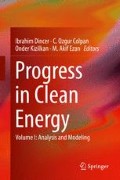Abstract
The Thiele–Winter reaction is of interest for synthesis of triacetoxyaromatic precursors of hydroquinones.
Solid acids such as heteropolyacids and activated zeolites have an efficient catalyst in acetoxylation reaction of quinones without the use of organic solvent at room temperature. Hydroquinones and substituted hydroquinones was easily oxidized at room temperature in quinones by using (Pc[Co]/K10) and air (1 atm). We have also tested this type of reaction in naphthoquinone series. Many naphthoquinones are natural products with interesting biological properties. The catalytic system (Pc[Co]/K10) in the presence of pure oxygen easily oxidizes the 1,5-dihydroxynaphthalene in Juglone (yield 87 %).
Access this chapter
Tax calculation will be finalised at checkout
Purchases are for personal use only
Abbreviations
- (Pc[Co]/K10):
-
Phthalocyanine (Co) supported on clay K10
- Ho:
-
Index hammett
- H3PMo12O40 :
-
Molybdophosphoric acid
- ClSO3H:
-
Chlorosulfonic acid
- H3PW12O40 :
-
12 Tunsto phosphoric acid
- H2SO4 :
-
Sulfuric acid
- (CH3)2(CO)2O:
-
Acetic anhydride
- Rt:
-
Room temperature
- Mp:
-
Melting points
- NMR:
-
Nuclear magnetic resonance
- IR:
-
Infrared spectroscopy
- UV:
-
Ultraviolet–visible spectrophotometry
- MO:
-
Microwave irradiation
- COCl2 :
-
Cobalt chloride
- H :
-
Hour
- p :
-
Power
- T :
-
Temperature
- t :
-
Time
- Λ :
-
Wavelengths
- ε λ :
-
Molar extinction coefficient
- H3SiW12O40 :
-
Tungstosilicic acid
References
McOmie JFW, Blatchey JM (1972) Thiele–Winter acetoxylation of quinones. Org React 9:199
Spyroudis S (2000) Hydroxyquinones: synthesis and reactivity. Molecules 5:1291
Lira AM, Araújo AAS, Basílio IDJ, Santos BLL, Santana DP, Macedo RO (2007) Compatibility studies of lapachol with pharmaceutical excipients for the development of topical formulations. Thermochim Acta 457:1
Sauriasari R, Wang DH, Takemura Y, Tsutsui K, Masuoka N, Sano K, Horita M, Wang BL, Ogino K (2007) Cytotoxicity of lawsone and cytoprotective activity of antioxidants in catalase mutant Escherichia coli. Toxicology 235(1–2):103–111
Windholz M (1993) The Merck index, 12th edn. Merck, Rahway
Combes R (1907) Procédé de préparation et de purification des dérivés oxyanthrquinoniques et oxynaphtoquinoniques en général, du juglonet de l’émodine en particulier. Bull Soc Chim France 4* série. I, pp 800–816
Soderquist CJ (1973) Juglone and allelopathy. J Chem Educ 50:782–783
Kessl JJ, Moskalev NV, Gribble GW, Nasr M, Meshnicr SR, Trumpower BL (2007) Parameters determining the relative efficacy of hydroxy-naphthoquinone inhibitors of the cytochrome bc1 complex. Biochim Biophys Acta 1767(4):319–326
Teimouri MB, Khavasi HR (2007) One-pot three-component regioselective synthesis of linear naphtho[2,3-b]-furan-4,9-diones. Tetrahedron 63:10269–10275
Valente C, Moreira R, Guedes RC, Iley J, Jaffar M, Douglas KT (2007) The 1,4-naphthoquinone scaffold in the design of cysteine protease inhibitors. Bioorg Med Chem 15(15):5340–5350
Thiele J (1898) Ueber die Einwirkung von Essigsäure-anhydrid auf Chinon und auf Dibenzoylstyrol. Ber Dtsch 31:1247–1249
Thiele J, Winter E (1900) Ueber die Einwirkung von Essigsäureanhydrid und Schwefelsäure auf Chinone. Ann Chem 311:341–352
Burton H, Praill PFG (1952) Acylation reactions catalysed by strong acids. Part VI. A comparison of zinc chloride and perchloric acid as catalysts for the Thiele acetylation of quinines. J Chem Soc 755–759
Gillspie R (1969) J Can Chem Educ 4:9
Michie JK, Miller JA (1981) Phosphorus trichloride as catalyst in the preparation of 1,1-diacetates from aldehydes. Synthesis 10:824–825
Kochhar KS, Bal BS, Deshpande RP, Rajadhyaksha SN, Pinnick HWJ (1983) Protecting groups in organic synthesis. Part 8. Conversion of aldehydes into geminal diacetates. J Org Chem 48:1765–1767
Elbs K (1993) Ueber nitrohydrochinon. J Prakt Chem 48:179
Villemin D (1996) Synthesis and encapsulated metal intercalated phtalocyanure without solvent under microwave irradiation. Actes of 3th Colloque Franco-Magrébin pp. 611
Hull NF, Conant JB (1927) A study of superacid solutions the use of the chloranil electrode in glacial acetic acid and the strength of certain weak bases. J Am Chem Soc 49:3047–3061
Olah GA, Pradash GKS, Sommer J (1985) Superacids. Wiley, New York
Olah GA (1993) Superelectrophiles. Angew Chem Int Ed Engl 32:767
Izumi Y, Urabe K, Onaka M (1992) Zeolite, clay and heteropolyacid, in organic reactions, vol 100. VCH, Weinheim, p 120
Dupont P, Lefebvre F (1996) Esterification of propanoic acid by butanol and 2-ethylhexanol catalyzed by heteropolyacids pure or supported on carbon. J Mol Catal A Chem 114(1–3):299–307
Izumi YK, Matsuo K, Urabe K (1983) Efficient homogenous acid catalysis of heteropoly acid and its characterisation through ether cleavage reactions. J Mol Catal 18:299–314
Author information
Authors and Affiliations
Corresponding author
Editor information
Editors and Affiliations
Rights and permissions
Copyright information
© 2015 Springer International Publishing Switzerland
About this chapter
Cite this chapter
Hammadi, M., Dokari, H., Villemin, D., Benferrah, N. (2015). Activated Zeolites and Heteropolyacids Have Efficient Catalysts for Synthesis Without Use of Organic Solvent at Room Temperature. In: Dincer, I., Colpan, C., Kizilkan, O., Ezan, M. (eds) Progress in Clean Energy, Volume 1. Springer, Cham. https://doi.org/10.1007/978-3-319-16709-1_38
Download citation
DOI: https://doi.org/10.1007/978-3-319-16709-1_38
Publisher Name: Springer, Cham
Print ISBN: 978-3-319-16708-4
Online ISBN: 978-3-319-16709-1
eBook Packages: EnergyEnergy (R0)

